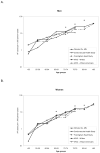Incidence of atrial fibrillation in whites and African-Americans: the Atherosclerosis Risk in Communities (ARIC) study
- PMID: 19540400
- PMCID: PMC2720573
- DOI: 10.1016/j.ahj.2009.05.010
Incidence of atrial fibrillation in whites and African-Americans: the Atherosclerosis Risk in Communities (ARIC) study
Abstract
Objectives: To define the incidence and cumulative risk of atrial fibrillation (AF) in a population-based cohort of whites and African Americans.
Background: African-Americans reportedly have a lower risk of AF than whites despite their higher exposure to AF risk factors. However, precise estimates of AF incidence in African Americans have not been previously published.
Methods: We studied the incidence of AF in the Atherosclerosis Risk in Communities (ARIC) study, which has followed up 15,792 men and women 45 to 65 years of age at baseline from 4 communities in the United States since 1987. Atrial fibrillation cases were identified from electrocardiograms conducted at baseline and 3 follow-up visits, and from hospitalizations and death certificates through the end of 2004. During follow-up, 1,085 new cases of AF were identified (196 in African Americans, 889 in whites).
Results: Crude incidence rates of AF were 6.7, 4.0, 3.9, and 3.0 per 1,000 persons per year in white men, white women, African-American men, and African-American women, respectively. Increasing age was exponentially associated with an elevated risk of AF. Compared to whites, African-Americans had a 41% (95% CI: 8%-62%) lower age- and sex-adjusted risk of being diagnosed with AF. The cumulative risk of AF at 80 years of age was 21% in white men, 17% in white women, and 11% in African-American men and women.
Conclusion: In this population-based cohort, African Americans presented a lower risk of AF than whites. Still, the burden of AF among the former is substantial, with 1 in 9 receiving a diagnosis of AF before 80 years of age.
Figures



References
-
- Rosamond W, Flegal K, Furie K, et al. Heart disease and stroke statistics--2008 update: a report from the American Heart Association Statistics Committee and Stroke Statistics Subcommittee. Circulation. 2008;117:e25–146. - PubMed
-
- Benjamin EJ, Wolf PA, D'Agostino RB, Silbershatz H, Kannel WB, Levy D. Impact of atrial fibrillation on the risk of death: the Framingham Heart Study. Circulation. 1998;98:946–952. - PubMed
-
- Go AS, Hylek EM, Phillips KA, et al. Prevalence of diagnosed atrial fibrillation in adults. National implications for rhythm management and stroke prevention: the Anticoagulation and Risk Factors in Atrial Fibrillation (ATRIA) study. Journal of the American Medical Association. 2001;285:2370–2375. - PubMed
-
- Miyasaka Y, Barnes ME, Gersh BJ, et al. Secular trends in incidence of atrial fibrillation in Olmsted County, Minnesota, 1980 to 2000, and implications on the projections for future prevalence. Circulation. 2006;114:119–125. - PubMed
-
- Wattigney WA, Mensah GA, Croft JB. Increasing trends in hospitalization for atrial fibrillation in the United States, 1985 through 1999. Implications for primary prevention. Circulation. 2003;108:711–716. - PubMed
Publication types
MeSH terms
Grants and funding
LinkOut - more resources
Full Text Sources
Medical

